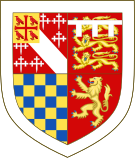| St Edmund's College | |
|---|---|
| University of Cambridge | |
 St Edmund's College Chapel and the original Norfolk Building | |
 Arms of St Edmund's College Arms: Arms of Henry Fitzalan-Howard, 15th Duke of Norfolk (quarterly of four: Howard, Brotherton, Warenne, FitzAlan) with a canton of St Edmund of Abingdon (Or, a cross fleury gules between four Cornish choughs proper[1]) all within a bordure argent | |
| Scarf colours: blue, with two equally-spaced narrow stripes of Cambridge blue edged with white | |
| Location | Mount Pleasant, Cambridge (map) |
| Full name | The Master, Fellows and Scholars of St Edmund’s College in the University of Cambridge |
| Latin name | Collegium Sancti Edmundi |
| Abbreviation | ED[2] |
| Motto | Per Revelationem et Rationem (Latin) |
| Founders | |
| Established | 1896 |
| Named after | Edmund of Abingdon |
| Previous names | St Edmund's House |
| Age restriction | 21 and older |
| Sister college | Green Templeton College, Oxford |
| Master | Chris Young |
| Undergraduates | 188 (2022-23) |
| Postgraduates | 528 (2022-23) |
| Endowment | £18.1m (2019)[3] |
| Visitor | Vincent Nichols, Archbishop of Westminster |
| Website | www |
| CR | www |
| Map | |
St Edmund's College is a constituent college of the University of Cambridge[4] in England. Founded in 1896, it is the second-oldest of the three Cambridge colleges oriented to mature students, which accept only students reading for postgraduate degrees or for undergraduate degrees if aged 21 years or older.
Named after St Edmund of Abingdon (1175–1240), who was the first known Oxford Master of Arts and Archbishop of Canterbury from 1234 to 1240, the college has Catholic roots. Its founders were Henry Fitzalan-Howard, 15th Duke of Norfolk, and Baron Anatole von Hügel (1854–1928), the first Catholic to take a Cambridge degree since the deposition of King James II in 1688.[5] The Visitor is the Archbishop of Westminster (at present Cardinal Vincent Nichols).[6]
The college is located on Mount Pleasant, northwest of the centre of Cambridge, near Lucy Cavendish College, Murray Edwards College and Fitzwilliam College. Its campus consists of a garden setting on the edge of what was Roman Cambridge, with housing for over 350 students.
Members of St Edmund's include cosmologist and Big Bang theorist Georges Lemaître, Norman St John-Stevas, Archbishop Eamon Martin, of Armagh, Bishop John Petit of Menevia, and Olympic medalists Simon Schürch (Gold), Thorsten Streppelhoff (Silver), Marc Weber (Silver), Stuart Welch (Silver) and Simon Amor (Silver). St Edmund's was the residential hall of the university's first Catholic students in 200 years – most of whom were studying for the priesthood – after the lifting of the papal prohibition on attendance at the universities of Oxford and Cambridge in 1895 at the urging of a delegation to Pope Leo XIII led by Baron von Hügel.[7]
- ^ Shown here erroneously as French martlets gules
- ^ University of Cambridge (6 March 2019). "Notice by the Editor". Cambridge University Reporter. 149 (Special No 5): 1. Retrieved 20 March 2019.
- ^ "Accounts for the year ended 30 June 2019" (PDF). St Edmund's College, Cambridge. Retrieved 22 February 2020.
- ^ Walker, Timea (21 January 2022). "St Edmund's College". www.undergraduate.study.cam.ac.uk. Retrieved 2 November 2022.
- ^ [email protected] (15 January 2014). "Baron Anatole von Hügel – Von Hügel Institute". www.vhi.st-edmunds.cam.ac.uk. Retrieved 31 March 2019.
{{cite web}}: CS1 maint: numeric names: authors list (link) - ^ "St Edmund's College - University of Cambridge". www.st-edmunds.cam.ac.uk. Retrieved 31 March 2019.
- ^ [email protected] (15 January 2014). "Baron Anatole von Hügel – Von Hügel Institute". www.vhi.st-edmunds.cam.ac.uk. Retrieved 2 April 2019.
{{cite web}}: CS1 maint: numeric names: authors list (link)

